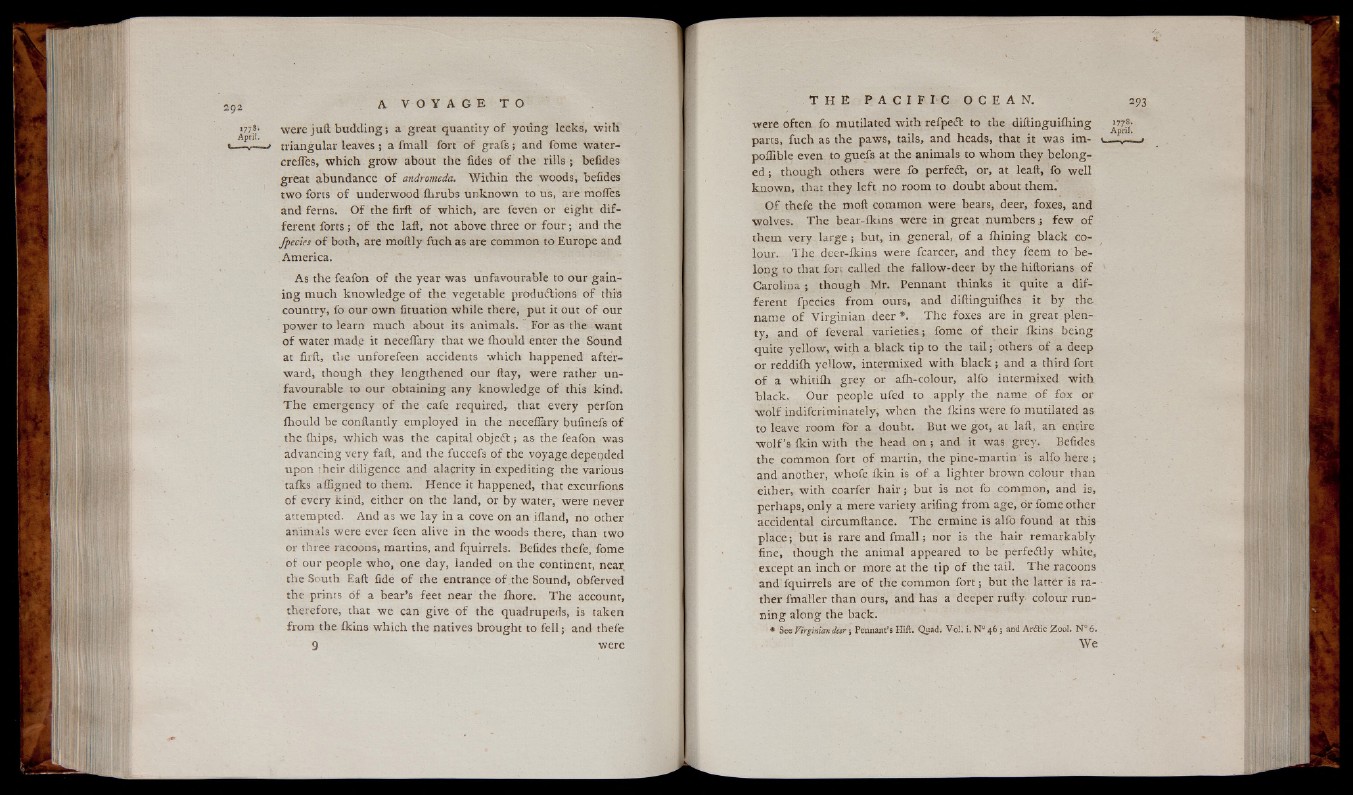
<77** were ju ft b u d d in g ; a great quantity o f you n g leeks, w ith
u— triangular leaves 5 a fmall fort o f grafs ; and fome water-
crefles, w h ich grow about the fides o f the rills ; befides
great abundance o f andrameda. Within the woods, befides
two forts o f underwood flirubs unknown to us, are mofles
and ferns. O f the firft o f w hich, are feven or e ight d ifferent
fo r ts ; o f the laft, not above three or f o u r ; and the
fpecies o f both, are moftly fuch as are common to Europe and
America.
As the feafon o f the year was unfavourable to our g a in in
g much knowledge o f the vegetable productions o f this
country, fo our own fituation while there, put it out o f our
power to learn much about its animals. For as the want
o f water made it neceflary that we ihould enter the Sound
at firft, the unforefeen accidents w hich happened afterward,
though they lengthened our ftay, were rather unfavourable
to our obtaining any knowledge o f this kind.
T h e emergency o f the cafe required, that every perfon
ihould be conflantly employed in the neceflary bufinefs o f
the fhips, which was the capital o b je c t ; as the feafon was
advancing very faft, and the fuccefs o f the voyage depended
upon their diligence and alacrity in expediting the various
tafks affigned to them. Hence it happened, that excurfions
o f every kind, either on the land, or by water, were never
attempted. And as w e la y in a cove on an ifland, no other
animals were ever feen alive in the woods there, than two
or three racoons, martins, and fquirrels. Befides thefe, fome
o f our people who, one day, landed on the continent, near,
the South Eaft fide o f the entrance o f the Sound, obferved
the prints o f a bear’s feet near the ihore. T h e account,
therefore, that we can give o f the quadrupeds, is taken
from the fkins which the natives brought to fe ll; and thefe
9 were
were often fo mutilated with refpeCb to the diftinguiihing ^7?sparts,
fuch as the paws, tails, and heads, that it was im- t — ,
poflible even to gu efs at the animals to whom they be longed
; though others were fo perfedt, or, at leaft, fo well
known, that they le ft no room to doubt about them.’
O f thefe the moft common were bears, deer, foxes, and
wolves. T h e bear-ikins were in great numbers.; few o f
them ve ry la rg e ; but, in general, o f a ihin ing black colour.
T h e deer-ikins were fcarcer, and they feem to belo
n g to that fort called the fallow-deer by the hiftorians o f '
C a ro lin a ; though Mr. Pennant thinks it quite a different
fpecies from ours, and diftinguilhes it by the
name o f Virg inian deer *. T he foxes are in great plenty,
and o f feveral v a r ie tie s ; fome o f their fkins being
quite y ellow , with a bla ck tip to the tail ; others o f a deep
or reddiih yellow, intermixed with bla ck ; and a third fort
o f a whitifh g re y or afh-colour, alfo intermixed with
black. Our people ufed to apply the name o f fo x or
w o lf indifcriminately, when the Ikins were fo mutilated as
to leave room for a doubt. But we got, at laft, an entire
w o l f ’s fkin with the head on ; and it was grey. Befides
the common fort o f martin, the pine-martin is alfo here ;
and another, whofe fkin is o f a lighter brown colour than
either, w ith coarfer h a i r ; but is not fo common, and is,
perhaps, only a mere variety arifing from age, dr fome other
accidental circumftance. T he ermine is alfo found at this
p la c e ; but is rare and fm a ll; nor is the hair remarkably
fine, though the animal appeared to be perfectly white,
except an inch or more at the tip o f the tail. T he racoons
and fquirrels are o f the common fo r t ; but the latter is rather
fmaller than ours, and has a deeper rufty colour runn
in g along the back.
* See Virginian deer; Pennant’ s Hiit. Quad. V o l. i. N ° 4 6 ; and Arctic Zool> N ° 6.
We